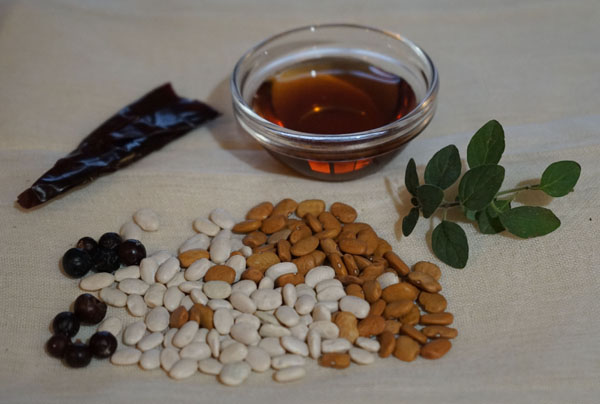
The Sioux Chef’s Indigenous Kitchen by Sean Sherman with Beth Dooly, University of Minnesota Press, Minneapolis, London, 2017. This book Tcame to me as a gift from my daughter. For a year it’s lain on the table by my reading chair, and I’ve spent hours flipping through its pages, admiring the photos, learning about the relationship of the land and indigenous peoples, and enjoying the stories of living with the bounty of our beautiful surroundings. But cook from the recipes? Well, I did make something with dandelion greens, but that is as far as I got. It’s not easy finding all the ingredients to make the recipes, and I gave up.
That changed when I came upon an article in a November issue of the New York Times: Sean Sherman’s 10 Essential Native American Recipes. Now I’m off and running to make “Tepary Beans with Chile-Agave Glaze”. I am re-inspired!
My first step is to gather my ingredients. Kind of like, turning on the oven. A start. It would be great if I could find the ingredients on our three acres of Colorado land, but the grasses and dandelions are brown with winter, we have no cedar branches, no wild grains, no fish, and I am not about to kill one of our bunny rabbits.
So I take my search instead to local and online stores. For Tepary Beans with Chile-Agave Glaze, I am searching for brown tepary beans, white tepary beans, agave nectar, and juniper berries. I also need chestnuts for a stuffing recipe, so I add these to my search list, as they are another of the foods discussed in the Sioux Chef.
Tepary Beans
First, the beans. The Sioux Chef tells me that beans are the “backbone of Native cuisine . . . add body to soups, stews, and salads . . . pureed, they become a dough for fritters, burgers, and croquettes”. And so many native beans they have! On pages 40-41, Sherman lists 22 kinds. A few I recognize: anazazi, black turtle (black beans), great northern, lima, navy, pinto, rice (wild rice), and southern peas (black-eyed peas). I learn that tepary beans are native to the Sonoran Desert of Arizona and Mexico. Their flavor is “earthy and pronounced”.
I turn to the internet for a source of tepary beans. Helpfully, the article in the NY Times gives me a link to Ramona Farms. On that site, I learn that tepary beans, or bafv, are among the world’s most drought-resistant edible beans. Ramona Farms is on the Gila River Indian Reservation in Arizona. Its proprietors are Ramona Button and her husband Terry. They work to preserve indigenous species of plants, including teparies, which had become almost extinct by the late 1970s. Luckily, the couple discovered that Ramona’s father had left “a few seeds of the white and brown tepary beans in glass jars in a trunk in the old adobe house that [Ramona] grew up in”. From this source, they are now able to offer them for sale to the local population and luckily, to interested foodies like me.
I add both brown and white tepary beans to my online cart at Ramona Farms. Then I add some “parched pima cornmeal”, just to try it. It is touted as “Hand harvested, hand parched, hand processed and packed to order! Great in cornbread. You will be surprised at the flavor the roasting adds to your cornbread. Get creative and make your own masa!” This parched cornmeal sounds interesting – I look forward to using it in cornbread. (P.S. A few days after I checked-out my Ramona Farms online cart, I get a personally written shipment confirmation. Nice touch.)
Agave
Agave nectar is the next ingredient on my search list. I learn from the Sioux Chef that indigenous peoples employed tree sap, honey, agave, and fruit as sweeteners. “Our ancestors relied on sweet foods for energy; they played an important role in a healthy diet and were not considered indulgences.” Generally, sweets were eaten throughout the day, for energy, as opposed to the European convention of having sweets after a big meal.
Agave “nectar” is more accurately called a “syrup”, as it is cooked down from the core of agave plants. Agave are big leafy plants of the species agave americana or agave tequilana (blue agave); they are also known as the century plant or American aloe. And yes, agave juice is fermented and distilled to make mescal. Tequila!
I kind of figure I can find agave nectar at Whole Foods, and I am correct. I have the choice of different brands and different types: light agave, blue agave, raw agave, or amber nectar. I decided to choose an agave nectar as close as possible to what the indigenous populations might have used, so I put a bottle of the dark, unfiltered agave nectar in my basket. Later, I find online that unfiltered agave nectar has more minerals than the other types. I also learn that light agave nectar has a mild flavor, amber nectar bit more caramel-like flavor, and dark or raw agave strong caramel notes and a distinctive flavor. If it is labeled “blue agave”, it is specifically made from that species of agave. The main sugar in agave nectars is fructose. Fructose is about one and a half times sweeter than sucrose, the main sugar in cane sugar (suggesting you would need less of it to sweeten a dish) and agave nectar has a relatively low glycemic index. This article on Healthline.com explains current nutritional thoughts on agave (2019).
Just what does agave taste like? I open my bottle of raw agave nectar and gently put a clean fingertip in . . . taste it . . . YUM! It’s less viscous than honey, and is very sweet with a pleasant flavor all its own. Not honey, not maple syrup, not brown sugary, just gently agave.
Juniper berries
Juniper berries are next. Decades ago, we actually had juniper plants in our planters, but (understandably) I did not save any seeds. Probably I will have to go to the Savory Spice Shop in Boulder for these, but I decide anyway to check while at Whole Foods. Voila! I find them in the spice section, near the bulk foods. A spice jar of dried juniper berries for less than 5 dollars.
According to the Sioux Chef on juniper: “We rely on the peppery astringent notes of juniper to do the work of pepper in our food . . . Fresh or dried, it’s best crushed before adding; note the the flavor is quite strong. Substitute with pepper.” This description in the first pages of the book illustrates how helpful the author is in helping his readers know how to use unusual ingredients, and how to substitute if necessary. On page 181, he states of the juniper: its “dusty blue berries are peppery and give foods a ginny edge”. The book includes includes photos and descriptions of juniper and also bergamot, sage, cedar, mint, staghorn sumac, mustard, and rose hips.
Chestnuts
Chestnuts are the final search item on my list. I check the index and flip to page 141 of the Sioux Chef. “Until the early 1900s, American chestnut trees filled our forests from Georgia to Canada, stretching west through Ohio to southern Wisconsin, Minnesota, and Iowa.” Around the turn of the twentieth century, “plant hobbyists introduced Asian chestnut trees and inadvertently imported a fungus”. Turns out, this fungus invaded American chestnut trees and decimated the population. Today’s American chestnuts are a hybrid variety.
I am a girl of the western US, California and Colorado, and have never seen chestnuts on a tree nor had them as a tradition in family meals. Never had “chestnuts roasting on an open fire”. Have no idea what they taste like. When I run across a Thanksgiving stuffing casserole recipe with chestnuts, I decide to make it. I find chestnuts at Whole Foods, a large jar of them, peeled and in some sort of liquid. Fifteen dollars! I get them anyway.
On to cooking!
As I finish writing the above sections, I get a notice from the post office that the tepary beans from Ramona Farms are at the post office. I will pick them up today, and I am pretty excited, just to think, they are heritage beans, grown by indigenous food devotees in Arizona. I am able to help support them as well as taste a bit of what the folks who used to live on our continent ate before us Europeans came and built supermarkets. So, to the post office I go! Then, home to cook.
Tepary Beans with Chile-Agave Glaze, adapted from Sean Sherman’s recipe in the New York Times
I studied Sherman’s recipe in the NY Times, then just plunged in. I did not measure exact ingredients, I treated it as a no-recipe recipe (ala Sam Sifton, NY Times). I used the vegetable oil I had around (the recipe suggests sunflower oil), and I used generic salt (the recipe calls for sea salt, which I learn from the Sioux Chef was a traded commodity, used often as currency). For the chili powder, I used pulverized dried New Mexico chilis. These were quite hot, so you may have to adjust the chile powder you use or the amount (I used about half a tablespoon). The juniper berries are my own addition to the recipe, and totally optional.
ingredients
- tepary beans
- agave nectar, preferrably unfiltered
- salt (sea salt if you have it)
- chile powder (use dried, pulverized New Mexico chiles or use jarred commercial chile powder)
- onions
- vegetable oil (calls for sunflower oil; I used a blend of canola and other oils)
- oregano (dried, fresh, Mexican or European)
- optional: a couple juniper berries, crushed
instructions
Begin the night before by soaking the tepary beans. I used 1/2 cup white and 1/2 cup brown tepary beans. First, pick over the beans, then put them in water to cover by a couple inches. (I actually soaked them two nights, the second night in the refrigerator.) After the soak, drain them and pick over again.
Put the tepary beans in a pot and cover with several inches of water. Add a teaspoon or so of salt. Bring to a boil and then simmer for about two hours, checking a few times for done-ness.
As an alternative cooking method in the future, I might try:
- a slow cooker: First on high for an hour, then on low for 6-8 hours.
- a pressure cooker: Soak a cup of tepary beans overnight, drain, then place in a pressure cooker with 2 cups water and some salt. Set the cooker to high pressure, 35 minutes, then allow the pressure to release naturally for 5 minutes before a quick pressure release. (Verified 2022. 35 minutes on high gets them almost soft, and the water above the cooked beans is sufficient. I removed a bit of that water and cooked the beans without pressure until the mixture was as I liked it and the beans done. I came up with this method using my studies of my electric pressure cooker in 2020.)
When the beans are tender, drain them. I ended up with 3-4 cups. Try to remember to save 1/2 cup of the cooking liquid (you sort of need it later).
Measure out as many tepary beans as you like for the meal at hand. I used one cup cooked beans and saved the rest for a chili or the like.
Saute about 1/4 cup onion in a tablespoon or so of vegetable oil until the onion is soft. Add the cooked, drained tepary beans and stir a few minutes. Taste for salt and adjust as to your liking. Add a tablespoon of agave nectar, half a tablespoon of chile powder, and about a half cup of the reserved bean-cooking liquid (or plain water, if you forgot); cook down until the water has evaporated and the beans are nicely glazed. Add a crushed juniper berry (if you have it, otherwise use some black pepper) and a scant teaspoon of dried oregano (Mexican oregano if you have it). Taste, and adjust seasonings. I ended up adding more agave nectar – my chiles were quite hot so I added no more of those. I served with a few fresh oregano leaves.
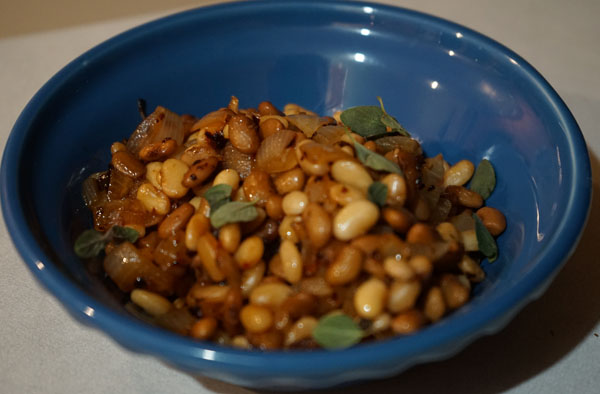
I liked these a lot. The tepary beans are earthy, and small and firm. The agave glaze makes them just wonderful.



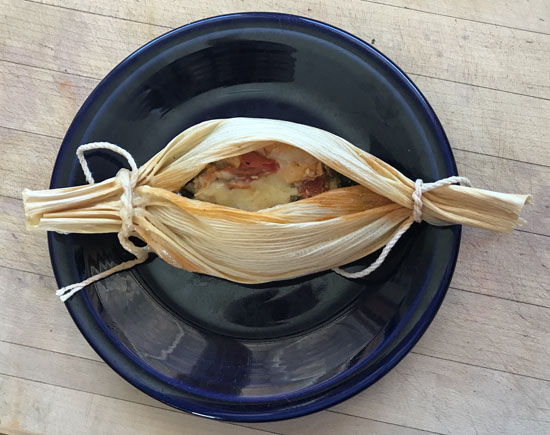
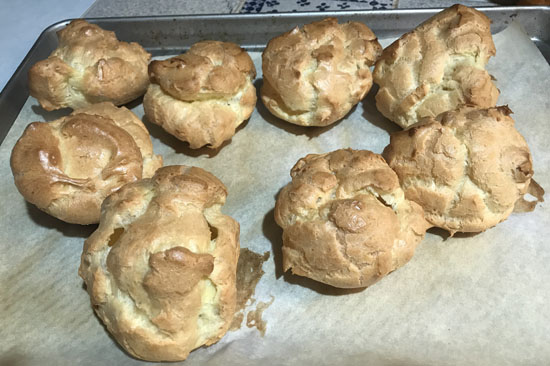
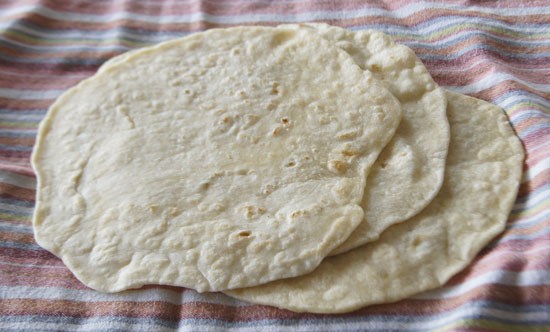

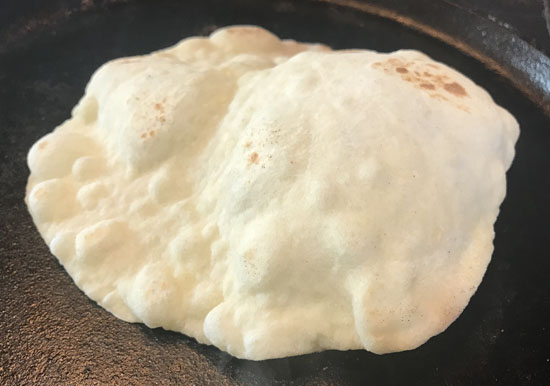

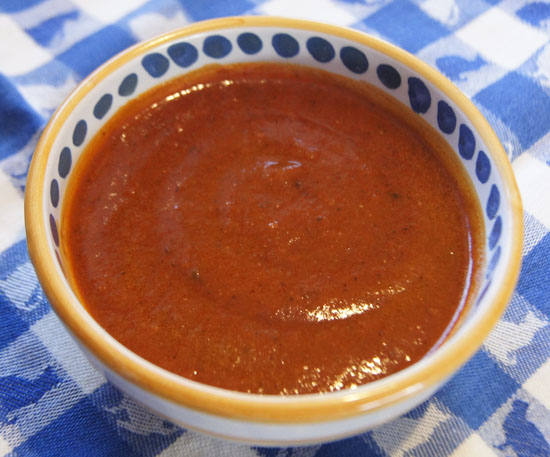
 The trick to my chicken and beef stocks is not how they are made, but how they are stored. I put the stocks in wide mouth in
The trick to my chicken and beef stocks is not how they are made, but how they are stored. I put the stocks in wide mouth in